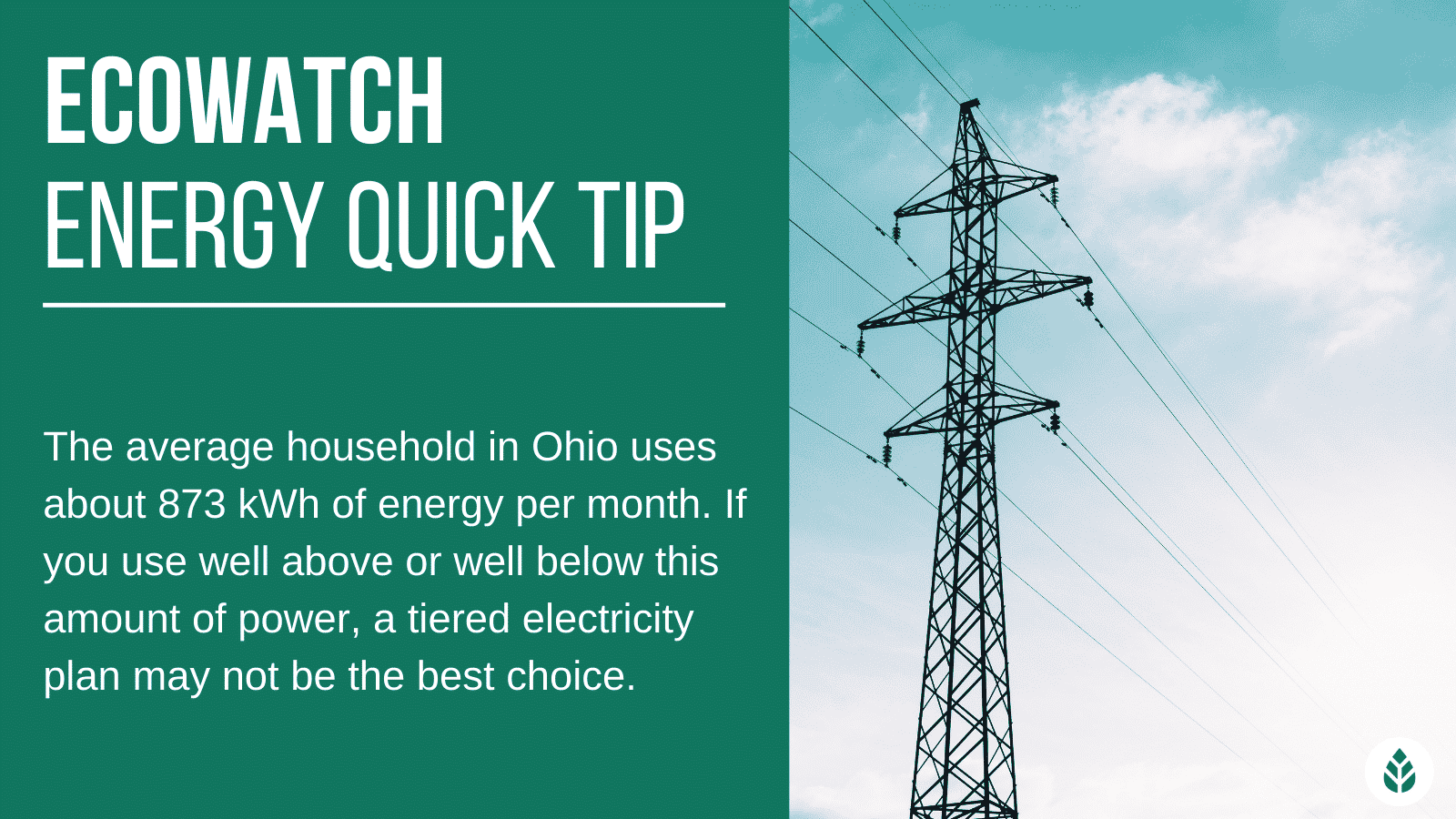 Climate
Climate
Ohio Electricity Rates and Providers (2024)
Here’s a quick overview of Ohio electricity prices:
Current average retail rate of electricity: 15.08 cents per kilowatt-hour (kWh)1
Current range of electricity prices in Ohio: 7.69 to 19.99 cents per kWh
Average monthly electric bill: $132.55
Average energy usage: 879 kWh per month
Information verified as of December 2022.
Each product and or company featured here has been independently selected by the writer. You can learn more about our review methodology here. If you make a purchase using the links included, we may earn commission.
Ohio Energy Rates
Ohio homeowners have access to over 80 energy supply companies, all of which purchase power from local power generation companies and sell it to you. Some of these companies have multiple plans for electricity, similar to internet providers that offer plan options for different Wi-Fi speeds at different monthly prices.
Depending on the electric utility provider you choose, you could be looking at three or more individual energy plans. Choosing the right plan for your needs and budget is important, especially because the cost of energy in Ohio is on the rise.
In the past year alone — October 2021 through October 2022 — the price of electricity in the Ohio area jumped around 19.5%, increasing from 17.9 cents per kWh to 21.4 cents per kWh.1 In the same time frame, the national average price of electricity rose only 15.5%.
The deregulated market for electricity does help some homeowners keep electricity bills to a minimum, but the base price of electricity — charged by your energy production company — is unavoidable. Current production companies in Ohio include:
- AES Ohio
- American Power
- Duke Energy Ohio
- Ohio Edison
- The Illuminating Company
- Toledo Edison
In the next section, we’ll discuss how energy costs from your supplier can vary and affect your total monthly energy costs. You can also use this tool to get instant access to the lowest energy prices in your area quickly.

CleanSky Energy

Regional Service
Average cost
Pros
- Wide variety of contract term options
- Low number of customer complaints
- Values transparency
- All plans use clean energy
Cons
- Charges contract cancellation fees
- No prepaid or no-deposit plans
- Expensive
CleanSky Energy is our top pick for clean energy plans in Ohio. The company offers three different fixed-rate options, which we recommend for customers in the Buckeye State. These contracts come with terms ranging from six to 24 months, so you can choose the term length that makes you most comfortable.
In addition to providing three clean energy plans, CleanSky maintains below-average pricing for its electricity. The lowest per-kWh rate offered to AEP customers is 9.65 cents, which is significantly lower than the statewide average of just over 15 cents per kWh.
CleanSky also has mostly positive online reviews, and it provides electric service to the majority of Ohio.
Facts and Figures: CleanSky Energy
| EcoWatch Rating |
|---|
| Better Business Bureau (BBB) Rating |
| Average Cost ($-$$$$$) |
| Solar Services |
| 4.5 |
| Not Rated |
| $$$$ |
| 100% Renewable Energy Plans, Fixed-Rate Plans, Business Energy Plans |

IGS Energy

Regional Service
Average cost
Pros
- All plans use clean energy
- Makes charitable contributions
- Low number of customer complaints
Cons
- Charges contract cancellation fees
- No prepaid or no-deposit plans
- Low number of plans to choose from
IGS Energy is based in Texas but serves portions of the northeast, including all of Ohio. Although it is a larger company, IGS maintains a remarkably low number of complaints from customers and has mostly positive reviews.
IGS offers Ohioans access to clean energy plans at fixed rates, which we recommend choosing. The contract terms are 12 or 36 months, and the cost per kWh remains below the statewide average for both options.
IGS also ranks high in our ratings because it is committed to sustainable energy, even outside of its green electricity plans. The company also offers carbon-neutral natural gas and access to solar energy, although neither of these services is provided in Ohio, specifically. Still, we like to see companies that support the clean energy movement as much as possible.
Facts and Figures: IGS Energy
| EcoWatch Rating |
|---|
| Better Business Bureau (BBB) Rating |
| Average Cost ($-$$$$$) |
| Solar Services |
| 4.5 |
| A+ |
| $$$ |
| 100% Renewable Energy Plans, Fixed-Rate Plans, Variable-Rate Plans, Business Energy Plans |

AEP Energy

Regional Service
Average cost
Pros
- Many years of experience
- Great industry reputation
Cons
- Charges contract cancellation fees
- No satisfaction guarantee
AEP Energy is Ohio’s largest electricity producer, and it also supplies electric power throughout most of the state.
Most of this company’s plans use fossil fuels like natural gas as a primary source of energy, but it does offer one 100% green energy option. It’s a fixed-rate plan, which is great, and although the term is lengthy at 36 months, the cost per kWh is below average at under 10 cents.
AEP has many years of experience, specifically in Ohio, so it understands the needs of residents and has a long history of success and satisfied customers. The company maintains mostly positive reviews as well.
Facts and Figures: AEP Energy
| EcoWatch Rating |
|---|
| Better Business Bureau (BBB) Rating |
| Average Cost ($-$$$$$) |
| Solar Services |
| 4 |
| A+ |
| $$$ |
| 100% Renewable Energy Plans, Fixed-Rate Plans, Business Energy Plans |
Ohio Energy Rates Over Time
In 2001, Senate Bill 3 was passed in Ohio, which deregulated the state’s energy market. Under a deregulated energy market, two companies work together to bring you power: your producer and your supplier. Your producer’s rates are regulated by the Public Utilities Commission of Ohio (PUCO), while your supplier’s rates are competitive due to the free market.
Before the bill passed, Ohio’s energy prices were above average — the goal of deregulating the market was to bring down the cost of electricity. Today, Ohioans pay just under the national average per kWh of electricity they use.
Energy deregulation in Ohio has done wonders for the cost of power in the state, but it also leaves homeowners with an important energy choice to make: Which electric supplier is best for your home? This decision can have a significant impact on your monthly energy bills as well as your carbon footprint and contribution to global warming.
Get Connected to a Power Supplier in Ohio
At EcoWatch, we care about the source of the energy that’s delivered to you and what you pay for it. You can use this tool to get help choosing an energy supplier to bring down costs, or you can use the links below to find the best prices for clean electricity in your area.
How Does Ohio’s Price of Electricity Compare Based on Company?
The chart below provides a complete breakdown of all of the electricity plans available in Ohio, including the contract term and the rate you’ll pay per kWh.
Keep in mind that, as we are a website focused on renewable energy and eco-friendliness, we only list plans that use clean energy sources to provide you with electricity.
How Do You Find the Best Electricity Rates in Ohio?
It may be tempting to choose a plan with the lowest cost per kWh since, in theory, it should yield the lowest overall energy bills. However, as we’ll discuss below, there are multiple factors to consider when choosing an energy plan to ensure you get the lowest rates and maintain affordable bills.
How Much Energy You Use
First, you’ll need to consider how much electricity your home consumes every month. Many of the residential energy providers (REPs) in Ohio use tiered rates to charge customers fairly, so your price per kWh can depend on your total monthly consumption in some cases.
Plans with tiered rates typically charge higher rates if a customer consumes below-average or above-average amounts of electricity.
In Ohio, the average monthly energy consumption is approximately 879 kWh. If you check your past energy bills and see that you average 500 kWh or 1,500 kWh, for example, you’ll likely pay higher per-kWh rates than a customer who consumes 900 kWh, which is closer to the state average.
This is important because it can significantly impact your total monthly energy bill. If you fall outside of the average energy consumption in your area, choosing a fixed-rate plan with a slightly higher per-kWh cost might save you more money.
When You Use the Most Electricity
You might also need to consider when you consume energy. Some electric utility companies in Ohio use a time-of-use (TOU) arrangement, which typically charges customers more per kWh during times of higher demand.
With a TOU plan, you might find that your per kWh price is significantly lower during off-peak times, like the early morning. Your supplier determines the specific times that rates rise or drop, so make sure to check with your utility company to learn more.
If you have a TOU plan, opting for the lowest per-kWh rate during off-peak times might not be beneficial if you’re using most of your energy during peak hours. You should instead pay attention to when you consume energy and which provider will lead to the lowest overall charges according to your schedule.
The Length of Your Contract
The length of the contract you enter into is also an important consideration when choosing an electricity plan. We typically recommend fixed-rate plans to customers in Ohio, which means you’ll be entering into a contract for anywhere from three to 36 months in most cases.
A fixed-rate contract charges you a specific rate per kWh for the length of your contract. When you choose a short contract, most companies will charge you a bit more per kWh since you only agree to use their service for a limited time. Companies like customer loyalty, so they often offer lower per-kWh prices for longer contracts.
It’s important to consider, though, that longer contracts can sometimes end up being more expensive in the long run due to fluctuations in energy prices. The examples below can help you see how energy rate changes could impact your savings over time.
- Fixed-rate plans can save you more than variable-rate plans if the average cost per kWh increases during the length of your contract
- Fixed-rate plans will end up costing you more than variable-rate plans over time if the market price of energy decreases over the length of your contract
- Fixed-rate plans and variable-rate plans can end up being similar in long-term price if the market average for energy remains about the same throughout your contract
We’ll talk more about fixed- and variable-rate plans and the pros and cons of each in the next section. If you need help figuring out which plan option is right for you, you can use this tool.
What Types of Electricity Plans Are Offered in Ohio?
In addition to choosing an energy plan with an affordable rate, you’ll also need to decide what kind of plan is right for you. There are five plan options in Ohio, including:
- Fixed-rate plans
- Variable-rate plans
- No-deposit/prepaid plans
- Renewable energy plans
- Business energy plans
Ohio Fixed-Rate Plans
A fixed-rate plan offers a single per-kWh rate that you’re guaranteed to pay for the length of your contract. Most contracts are between 12 and 36 months, but they can be as short as three to six months.
We recommend fixed-rate plans to most Ohio customers because they allow you to better plan your expenses and budget for bills. Your energy bills will still fluctuate based on usage, but you’ll never be stuck with an unexpectedly high bill because of rising energy costs.
Fixed-rate plans can end up being more costly over time if the market price of energy goes down. Also, keep in mind that these plans will automatically turn into a variable-rate plan at the end of the contract, so you may need to enroll in another fixed-rate plan down the line.
Pros and Cons: Fixed-Rate Plans
| Pros of a Fixed-Rate Energy Plan | Cons of a Fixed-Rate Energy Plan |
| Easier to budget for bills | Typically have early termination fees |
| Energy rates remain the same, even if local rates rise | If energy rates drop, you could miss out on energy savings |
Variable-Rate Plans for Ohio
As the name implies, variable-rate plans charge you a variable or changing rate per kilowatt-hour of energy you use. The rate is determined using the market price for energy, which means your rate can skyrocket in times of high demand or during times of crisis, but it can also drop if demand goes down. These plans are unpredictable, which can make budgeting for your energy bills a challenge.
Variable-rate plans are beneficial for a few reasons, including no required contract and, often, no sign-up or cancellation fees.
Variable-Rate Plan Pros and Cons
| Pros of a Variable-Rate Energy Plan | Cons of a Variable-Rate Energy Plan |
| If the local price of electricity is low, you could save money | Energy prices can spike during times of high demand or crisis |
| Most don’t have a fixed term or early termination fees | Local energy prices could always increase, costing you more money |
No-Deposit and Prepaid Energy Plans in Ohio
Many electric companies in Ohio require a deposit to sign up for a plan, which can help offset losses from customer non-payments. But some providers will waive the deposit if you have good credit.
No-deposit energy plans are one option if you prefer not to put down a deposit, but a credit check may still be required.
Prepaid energy plans are similar in that they usually don’t require a deposit, but they work a bit differently. Rather than paying your energy bill at the end of each month, a prepaid plan lets you put money into an energy fund and pull from that money to pay for the energy you consume.
Since you choose how much to deposit into your fund, prepaid plans allow you to budget exactly how much you’ll spend on energy. However, if you forget to add funds to your account regularly, you could experience temporary service outages.
Pros and Cons: Prepaid Energy Plans
| Pros of a Prepaid Energy Plan | Cons of a Prepaid Energy Plan |
| No deposit or upfront costs | You might lose power if you forget to add funds to your account |
| No unexpected bills | Higher per-kWh rates, in most cases |
| No contracts or early termination fees |
Green Energy Plans in Ohio
Green energy plans generate all of the electricity you use from renewable energy sources, like solar, wind and hydroelectricity. We recommend these plans because they reduce your carbon footprint and allow you to adopt clean energy without investing in expensive equipment like solar panels.
Clean energy plans can sometimes be a bit more expensive on a per-kWh basis. However, many of the companies in Ohio that offer these plans do what they can to keep costs down and end up offering below-average prices for clean energy.
Pros and Cons: Green Energy Plans
| Pros of a Renewable Energy Plan | Cons of a Renewable Energy Plan |
| Reduces your carbon footprint and helps the environment | Can be more expensive than other plans, usually between 1 to 2 cents more per kWh |
| Allows you to support solar and wind energy without the high installation costs | Fewer plan options available |
Business Energy Plans
Business energy plans are designed for companies, including commercial, industrial and government consumers, rather than residential customers. These plans typically have lower per-kWh rates because they account for office buildings, churches, local government headquarters or other large buildings that have higher rates of energy consumption.
These plans are less common than residential options, but they’re still often offered with fixed rates and variable rates in Ohio. If you need a small business plan, you may have to do some searching to find available options in your area.
Pros and Cons: Business Energy Plans
| Pros of a Business Energy Plan | Cons of a Business Energy Plan |
| Lower cost per kWh due to higher energy use | Only available for commercial customers |
| Energy efficiency loans, clean energy grants and other energy aids available | Fewer plan options available compared to residential options |
What Should You Look for When Choosing an Electricity Provider in Ohio?
With over 80 REPs in Ohio, there are a few factors to keep in mind as you choose a company that is best suited to your energy needs. Below, we’ll include some information about what to look for in your electricity provider.
We recommend focusing on different factors if you’re a new Ohio homeowner looking to establish electricity services, versus if you live in the state already and are looking to switch providers. For tailored advice, skip to the section below that makes the most sense for your situation.
Picking Electricity Providers as a New Ohio Resident
If you’re planning to move to Ohio as a new resident, electricity companies will likely offer you a handful of perks upfront, including:
- Introductory prices for energy, which typically go up after about a year
- Waived sign-up fees or deposits
- Incentives, including prepaid gift cards
While these perks can be enticing, we recommend first looking at the basics of the programs available to you, including the cost per kWh, the term, whether the rate is variable or fixed and company reviews.
The cost per kWh and type of rate (variable or fixed) will largely determine where your energy bills fall. Choosing lower per-kWh prices will almost always lead to lower bills overall.
We also recommend choosing a fixed-rate plan, at least at first. Since you’re unfamiliar with the area and adjusting to expenses with your new home, a fixed-rate plan provides some peace of mind that at least your energy bills will remain relatively constant.
The term of the plan is also an important consideration. Since new homeowners can face many decisions at once, it might benefit you to choose a year-long term so you can reassess the service after a year of settling into your new home.
Finally, you should read through positive and negative company reviews online before deciding. As a new resident, you’ll likely be unfamiliar with the companies in the area and their reputations. Browsing company reviews is an easy way to get a sense of the service you can expect from providers in your area.
Selecting an Energy Provider if You Are Switching Providers in Ohio
If you’re already living in Ohio and looking to switch electric providers, your priorities might differ from those of a new resident. For transitioning customers, we recommend focusing on the rate first along with the type of plan and then considering the term.
As an existing Ohio homeowner, you likely have an idea of the average cost per kWh, so you can more easily scan available providers for a better deal.
Once you find a rate that will lower your energy bill, you can consider the type of plan and contract term, if applicable. We typically recommend fixed-rate contracts, but if you feel comfortable with how the electricity market can change over time, you could also consider variable-rate plans.
The term length is also important when choosing your plan. Since you have a history of living in Ohio, you may already know which rate per kWh is worth a lengthy contract. But generally, you can keep long-term costs down by choosing a plan with a low fixed rate and a long contract term.
What Are 100% Green Energy Plans?
If you choose a 100% green energy plan instead of a supplier that uses fossil fuels, all of your electricity will come from clean energy sources, including:
- Solar power
- Wind power (the most common form of clean energy in Ohio)2
- Biomass
- Hydroelectric power
Green energy plans function just like other electricity plans so they can be:
- Set at fixed or variable rates
- Month-to-month plans
- Plans with a set contract term (from one to three years, on average)
- No-deposit plans
- Prepaid plans
Renewable energy plans offer the opportunity to join the clean energy movement, reduce your carbon footprint and reduce your contribution to pollution and global warming, all without buying expensive equipment like solar panels.
These plans can be more costly per kWh, but many providers in Ohio maintain below-average prices.
Who Offers Green Energy Plans in Ohio?
Ohio is home to just under 90 energy suppliers. Of those suppliers that source power from AES, Ohio’s largest electricity producer, 17 offer green energy plans.
Below, we’ll include a quick list of all of the REPs that offer green energy plans — for AES customers — in Ohio.
- AEP Energy Inc
- Alpha Gas & Electric LLC
- CleanChoice Energy
- CleanSky Energy
- Direct Energy Services LLC
- IDT Energy Inc
- IGS Energy
- Inspire Energy Holdings
- Kiwi Energy
- North American Power & Gas
- Provision Power & Gas
- Residents Energy LLC
- Santanna Energy
- Shipley Choice LLC
- SunSea Energy Ohio
- Think Energy
- Tomorrow Energy Corp
You can use this tool to find suppliers that offer green energy plans and compare prices to see which provider suits you best.
What Are the Best Electricity Companies and Providers in Ohio?
Below are some of our top-rated electric companies in Ohio and key facts about each to help you decide which might be right for you.
CleanSky Energy — Best Overall
- Many term options available
- Fixed-rate plans available
- 100% renewable energy plans
- Positive online reviews
- Serves most Ohio homeowners
| Plan Name | Contract Length | Average Rate (¢/kWh) |
| CleanSky Energy Embrace Green 6 | 6 months | 11.99 cents |
| CleanSky Energy Embrace Green 12 | 12 months | 9.69 cents |
| CleanSky Energy Embrace Green 24 | 24 months | 9.65 cents |
IGS Energy — Best Customer Service
- Fixed-rate plans available
- 100% renewable energy plans
- Limited plan options to choose from
- Low number of complaints from customers
- Competitive prices
| Plan Name | Contract Length | Average Rate (¢/kWh) |
| IGS Energy 100% Green Energy 12 | 12 months | 9.69 cents |
| IGS Energy 100% Green Energy 36 | 36 months | 10.99 cents |
AEP Energy — Most Affordable
- Supports renewable energy and offers renewable energy plans
- Serves most Ohio property owners
- Fixed-rate plans available
- Years of experience
- Many positive online reviews
| Plan Name | Contract Length | Average Rate (¢/kWh) |
| AEP Energy Inc 100% Clean Energy Plan | 36 months | 9.89 cents |
CleanChoice Energy — Best for Variable-Rate Clean Energy Plans
- Renewable energy plans available
- Community solar plans available
- Easy cancellation
- A+ rating from the Better Business Bureau (BBB)
- Positive online reviews
| Plan Name | Contract Length | Average Rate (¢/kWh) |
| CleanChoice Energy, Inc Choose 100% Clean Plan | 12 months | 9.5 cents |
Additional Popular Energy Providers in Ohio
Since we’re a website that focuses on environmental friendliness, we’ve chosen to highlight the companies that provide energy plans that source 100% of their energy from clean sources. However, there are additional providers in the area that source some clean energy and provide a mix of renewable sources and fossil fuels.
The chart below outlines some of the plans that offer 25%, 50% and 75% clean energy mixes.
| Provider | Lowest Available Rate (¢/kWh)* | Plan Length | Percent of Renewable Energy* | Pros | Cons |
| American Power and Gas of Ohio | 6.59 cents | 12 months | 25% | Provides plans with some access to clean energy at low rates | Low plan rates are linked to variable-rate options |
| New Wave Energy Corp | 8.80 cents | 12 months | 15% | Provides plans with some access to clean energy | Relatively low green percentage at a variable-rate only |
| NRG Home | 9.50 cents | 3 months | 25% | Provides plans with some access to clean energy | Variable-rate plan only |
| Santanna Energy | 8.19 cents | 12 months | 4% | Provides plans with some access to clean energy at low rates | Plans offer minimal access to renewable energy |
| Kiwi Energy | 10.46 cents | 36 months | 50% | Provides plans with a mix of half clean energy | Plans offer a long contract terms at a variable-rate only |
| Xoom Energy Ohio LLC | 12.59 cents | 1 months | 50% | Provides plans with a mix of half clean energy | Variable-rate plan only |
| Xoom Energy Ohio LLC | 10.79 cents | 12 months | 50% | Provides plans with a mix of half clean energy at a fixed-rate | Plans offer an above-average per-kWh rate |
FAQ: Ohio Electricity Plans
The EcoWatch team is happy to get questions frequently from Ohio homeowners about which electric utility company to choose. Below are some of the questions we see most often, along with our responses.
Inspire Energy has the cheapest renewable energy plan in Ohio. The average rate per kWh in Ohio is 15.08 cents, and Inspire Energy’s 100% Clean Energy Plan has a rate of just 7.69 cents per kWh. More so, all of the electricity provided by this plan comes from renewable energy sources.
The answer to this question will be highly individualized, as not every provider has plans and budget options that are suitable for every homeowner. However, AEP Energy is one of Ohio’s best electricity suppliers. This company has a large local service area including Columbus, Cleveland, Akron, Dayton, Delaware, Dublin and Cincinnati. It also has renewable energy plans, offers fixed-rate payment options, has years of local experience and maintains mostly positive reviews online.
The average monthly utility bill in Ohio is around $132.55, which is based on the most recent data from the US Energy Information Administration. This is assuming the average per-kWh price of 15.08 cents in Ohio and an average consumption of 879 kWh per month.
Since there is deregulation and an open market for electricity in Ohio, one of the best ways to lower your power bill is to choose a supplier with a rate that meets your budget. You can use this tool to help compare energy suppliers in Ohio and select the one that makes the most sense for you.
You can also make good decisions when it comes to power usage by doing the following:
- Turning off lights when you leave a room
- Keeping your thermostat at a reasonable temperature when you’re not home, or using a smart thermostat to minimize energy usage
- Improving your home with new windows, doors and insulation.
You can check out our guide on minimizing energy usage for more tips.
It’s nearly impossible to say which energy plan in Ohio is best because not every plan is the best option for every homeowner. You need to personally optimize the plan you agree to based on the per-kWh rate, the type of plan, the term and much more.
We suggest checking out renewable energy plans offered by CleanSky Energy, IGD Energy, AEP Ohio and CleanChoice Energy to get started.

 233k
233k  41k
41k  Subscribe
Subscribe 








